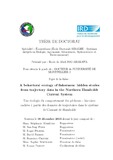Por favor, use este identificador para citar o enlazar este ítem:
https://hdl.handle.net/20.500.12958/2338| Título : | A behavioral ecology of fishermen: hidden stories from trajectory data in the Northern Humboldt Current System |
| Autor : | Joo, Rocío |
| Palabras clave : | Localización De Buques;Embarcaciones Pesqueras;Pescadores - Comportamiento;Humboldt Norte |
| Fecha de publicación : | 2013 |
| Editorial : | Montpellier, Francia |
| Resumen : | This work proposes an original contribution to the understanding of fishermen spatial behavior, based on the behavioral ecology and movement ecology paradigms. Through the analysis of Vessel Monitoring System (VMS) data, we characterized the spatial behavior of Peruvian anchovy fishermen at different scales: (1) the behavioral modes within fishing trips (i.e., searching, fishing and cruising); (2) the behavioral patterns among fishing trips; (3) the behavioral patterns by fishing season conditioned by ecosystem scenarios; and (4) the computation of maps of anchovy presence proxy from the spatial patterns of behavioral mode positions. At the first scale considered, we compared several Markovian (hidden Markov and semi-Markov models) and discriminative models (random forests, support vector machines and artificial neural networks) for inferring the behavioral modes associated with VMS tracks. The models were trained under a supervised setting and validated using tracks for which behavioral modes were known (from on-board observers records). Hidden semi-Markov models performed better, and were retained for inferring the behavioral modes on the entire VMS dataset. At the second scale considered, each fishing trip was characterized by several features, including the time spent within each behavioral mode. Using a clustering analysis, fishing trip patterns were classified into groups associated to management zones, fleet segments and skippers’ personalities. At the third scale considered, we analyzed how ecological conditions shaped fishermen behavior. By means of co-inertia analyses, we found significant associations between fishermen, anchovy and environmental spatial dynamics, and fishermen behavioral responses were characterized according to contrasted environmental scenarios. At the fourth scale considered, we investigated whether the spatial behavior of fishermen reflected to some extent the spatial distribution of anchovy. Finally, this work provides a wider view of fishermen behavior: fishermen are not only economic agents, but they are also foragers, constrained by ecosystem variability. To conclude, we discuss how these findings may be of importance for fisheries management, collective behavior analyses and end-to-end models. |
| Descripción : | Tesis (Doctorat). -- Universite de Montpellier II |
| URI : | https://hdl.handle.net/20.500.12958/2338 |
| Aparece en las colecciones: | Tesis de Postgrado |
Ficheros en este ítem:
| Fichero | Descripción | Tamaño | Formato | |
|---|---|---|---|---|
| Joo-PhD-2013.pdf | 6,19 MB | Adobe PDF |  Visualizar/Abrir |
Este ítem está sujeto a una licencia Creative Commons Licencia Creative Commons

